















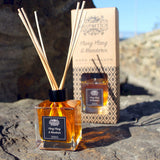
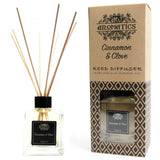
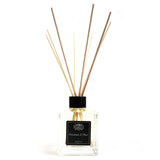
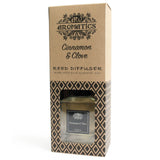
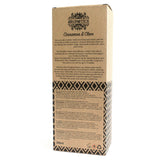
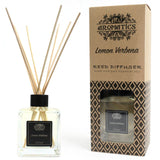
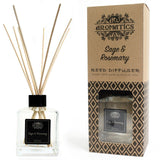
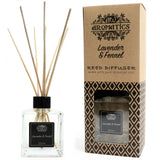
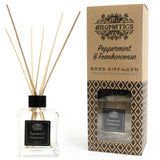
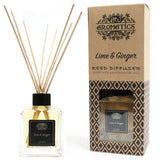
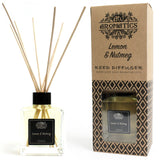
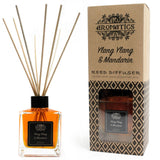
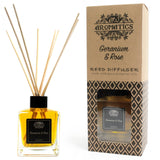
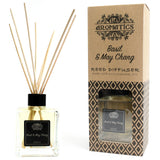
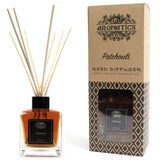
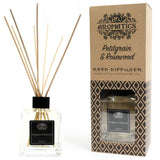
AromaLux - Pure Essential Oils Reed Diffusers
Experience the luxury of Pure Essential Oils Reed Diffusers by SB Lux. Indulge your senses with our range of delightful fragrances that will transform your home into a relaxing and aromatic haven.
Our reed diffusers come in a variety of scents to suit your mood and preference. From the warm and spicy Cinnamon & Clove to the refreshing Lime & Ginger, there's a scent for every occasion. Other variants include Lemon Verbena, Sage & Rosemary, Lavender & Fennel, Peppermint & Frankincense, Lemon & Nutmeg, Ylang Ylang & Mandarin, Geranium & Rose, Basil & Maychang, Patchouli Essential Oil, and Petitgrain & Rosewood.
Made with essential oils and a special eco-mineral oil base, our diffusers are designed to last up to 12 weeks, allowing you to enjoy the aroma for longer. The diffuser set is elegantly presented in a classy box, making it the perfect gift for any occasion. And with the reed sticks slowly and delicately releasing the fragrance, your customers will feel a sense of relaxation and calm wash over them.
Our Pure Essential Oils Reed Diffusers are handmade in the UK and are SLS, SLES, and paraben-free, making them suitable for vegetarians and vegans. They're also cruelty-free, so you can feel good about using them in your home.
Transform your living space into an aromatic haven and experience the luxury of our Pure Essential Oils Reed Diffusers and Go on an aromatic adventure today!
Materials You'll Need:
- Essential oil reed diffuser (including reeds and a container with scented oil)
- Optional: Extra reeds or skewers for replacement
Step-by-Step Instructions:
-
Set Up:
- Choose a location for your reed diffuser. It's best to place it on a stable surface away from direct sunlight, heat sources, and air conditioning vents. A central location in the room allows for even distribution of the scent.
-
Open the Package:
- If your reed diffuser comes with packaging, carefully remove it and any plastic or protective wrapping.
-
Insert the Reeds:
- Open the bottle of scented oil and insert the reeds or bamboo sticks into the bottle. Place them in such a way that they are evenly spaced and can fan out naturally.
-
Soak the Reeds:
- Allow the reeds to soak in the scented oil for about 1-2 hours. During this time, the oil will start to travel up the reeds, and the scent will begin to diffuse.
-
Flip the Reeds:
- After the initial soaking period, carefully remove the reeds from the bottle and flip them over so that the soaked ends are now exposed to the air. This helps the scent continue to diffuse effectively.
-
Adjust the Scent Intensity:
- To adjust the intensity of the scent, you can vary the number of reeds you insert into the bottle. The more reeds you use, the stronger the scent will be.
-
Enjoy the Aroma:
- As the reeds continue to absorb the scented oil, they will release the fragrance into the air. You'll notice a subtle and consistent aroma filling the room.
-
Maintenance:
- To refresh the scent, you can flip the reeds once a week or whenever you notice the fragrance becoming faint. Gently turning the reeds helps to re-saturate them with the scented oil.
-
Replacement:
- Over time, the reeds may become saturated with old oil and lose their effectiveness at diffusing the scent. If this happens, you can replace the reeds with new ones or trim the ends of the existing reeds to encourage better scent diffusion.
-
Refill:
- When the scented oil in the bottle runs low, you can purchase a refill or create your own blend of carrier oil and essential oils to replenish the diffuser.
-
Safety Precautions:
- Keep the diffuser out of reach of children and pets.
- Place the diffuser on a stable surface to prevent spills.
- Essential oils can stain surfaces, so make sure the diffuser is placed on a suitable surface.
- Wash your hands after handling essential oils to avoid accidental contact with eyes or sensitive areas.
Using an essential oil reed diffuser is a simple and effective way to enjoy the benefits of aromatherapy and create a pleasant atmosphere in your living space.
-
Ancient Origins: Aromatherapy has been practiced for thousands of years, with evidence of its use found in ancient civilizations like Egypt, China, and India. Essential oils were used for their therapeutic properties and in various rituals.
-
Highly Concentrated: Essential oils are extracted from plant materials using methods like steam distillation or cold pressing. They are highly concentrated and can contain the essence and aroma of the plant in just a few drops.
-
Powerful Scents: The olfactory system, responsible for our sense of smell, is closely linked to our emotions and memory. Inhaling certain essential oils can evoke specific feelings and trigger memories.
-
Not Oils in the Traditional Sense: Despite the name, essential oils aren't true oils in the traditional sense, as they don't contain fatty acids. Instead, they're volatile compounds extracted from plants.
-
Hundreds of Varieties: There are over 90 types of essential oils available, each with its own unique scent and potential benefits. Common ones include lavender, tea tree, peppermint, lemon, eucalyptus, and more.
-
Plant Parts Matter: Different parts of a plant can yield different essential oils. For example, rose essential oil comes from the petals of the flower, while cedarwood oil is derived from the wood of the tree.
-
Synergy in Blends: Many aromatherapists believe that blending different essential oils can create a synergy that enhances their individual properties. Blends can have more complex and powerful effects.
-
Carrier Oils: Carrier oils, like coconut, jojoba, and almond oil, are used to dilute essential oils before applying them to the skin. This helps prevent skin irritation and makes the oils easier to spread.
-
Global Roots: Aromatherapy draws from a wide range of cultures and traditions. Different cultures have their own traditional oils and methods of application.
-
Therapeutic Uses: Aromatherapy is used for various therapeutic purposes, including stress relief, relaxation, boosting mood, promoting sleep, alleviating headaches, and even supporting certain health conditions. However, it's important to note that while some claims are backed by scientific research, others are more anecdotal.
-
Cautions and Safety: Essential oils are potent and should be used with care. Some oils can cause skin irritation or adverse reactions, and some are not safe for certain groups, like pregnant individuals or pets.
-
Eco-Friendly Options: Aromatherapy offers an eco-friendly alternative to synthetic air fresheners and perfumes. By using natural essential oils, you can create pleasant scents without harmful chemicals.
-
Customization: Aromatherapy is highly customizable. You can experiment with different oils and blends to find what works best for you and your desired effects.
Remember that while aromatherapy can offer various benefits, individual responses may vary. If you're new to using essential oils, it's a good idea to start with a small amount and observe how your body responds. If you have specific health concerns, consult a qualified aromatherapist or healthcare professional for guidance.
